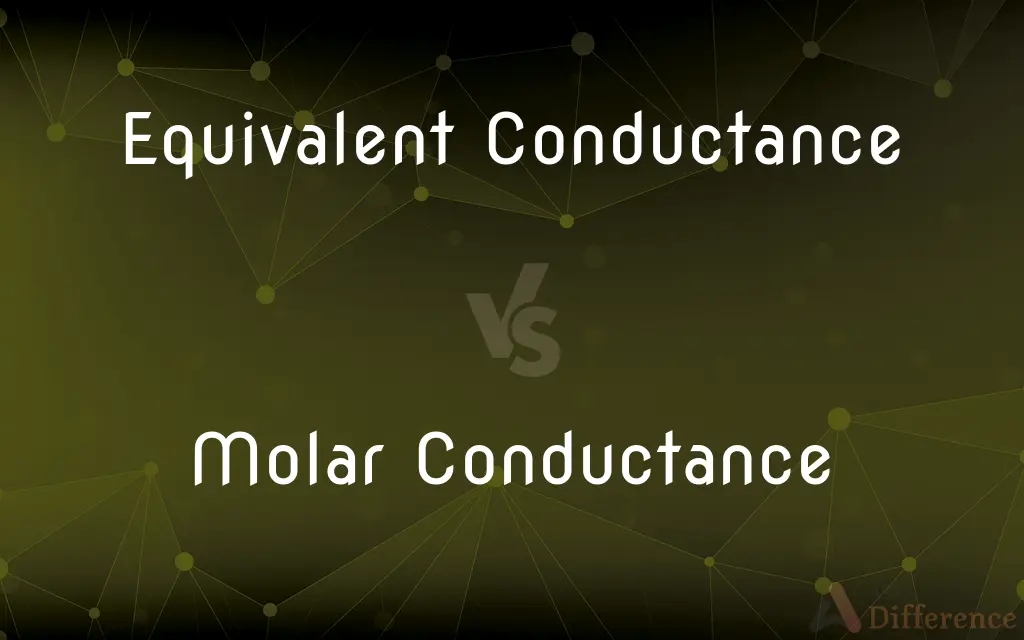Equivalent Conductance vs. Molar Conductance — What's the Difference?
By Tayyaba Rehman — Published on November 8, 2023
Equivalent Conductance pertains to conductance of ions per equivalent while Molar Conductance refers to conductance per mole; both are affected by ion concentration and type.

Difference Between Equivalent Conductance and Molar Conductance
Table of Contents
ADVERTISEMENT
Key Differences
Equivalent Conductance is the conductance of an electrolyte divided by the amount of the electrolyte in equivalents. Molar Conductance, conversely, expresses conductance concerning a mole of the electrolyte. The former essentially provides a measure of the electrolytic conductivity per equivalent weight of the electrolyte, which essentially relates to its capability to conduct electricity. In contrast, Molar Conductance provides a look into how well an electrolyte can conduct electricity per mole, offering insight into its conductive properties without reliance on equivalent weight.
Equivalent Conductance is usually symbolized by
Λ
�
eq
ADVERTISEMENT
or
C
. Molar Conductance, on the other hand, is generally represented by
m
. While Equivalent Conductance allows one to assess conductivity through a lens of fundamental charge-carrying capacity, Molar Conductance positions its evaluative framework within the realm of mole-based assessment. Hence, they serve as functional metrics for different contexts and needs within electrochemical analysis and application.
Understanding Equivalent Conductance often comes hand-in-hand with an appreciation for the principles of ionization and conductivity. Molar Conductance, while also interfacing with these principles, emphasizes aspects like electrolyte concentration and its molar attributes. These metrics, while discussing similar realms, carry divergent implications and applications due to their distinctive denominator bases (equivalent and molar, respectively).
It's crucial to recognize that Equivalent Conductance typically diminishes with a rise in dilution. However, Molar Conductance typically shows an increase with dilution, reflecting the disparate ways in which these two metrics respond to changes in electrolyte concentration. The relation between these two conductances and dilution or concentration outlines their crucial role in deciphering electrolyte behavior under various conditions.
Equivalent Conductance and Molar Conductance are both integral to electrochemistry, enabling the dissection of electrolyte conductive behaviors in distinct but complementary ways. While Equivalent Conductance could provide more value in scenarios concerning ion equivalents and basicity, Molar Conductance might be particularly germane to contexts that leverage molar concentration as a pivotal factor.
Comparison Chart
Definition Basis
Based on equivalents of electrolyte
Based on moles of electrolyte
Dependency
Decreases with dilution
Increases with dilution
Application Relevance
Relevant for ion equivalents
Relevant for molar concentration
Compare with Definitions
Equivalent Conductance
Equivalent Conductance provides insights into electrolyte dissociation.
Observing Equivalent Conductance can reveal the degree of ionization in solutions.
Molar Conductance
Molar Conductance often enhances with dilution.
Molar Conductance is useful for understanding the impact of dilution on conductivity.
Equivalent Conductance
Equivalent Conductance is inversely proportional to concentration.
As you dilute the solution, its Equivalent Conductance generally increases.
Molar Conductance
Molar Conductance quantifies conductivity per mole of electrolyte.
As you dilute acetic acid, its Molar Conductance will typically increase.
Equivalent Conductance
Equivalent Conductance can vary with temperature and electrolyte type.
At higher temperatures, the Equivalent Conductance of an electrolyte might change.
Molar Conductance
Molar Conductance illuminates the electrolyte’s inherent conductive capacity.
This solution exhibits low Molar Conductance, indicating weak conductivity.
Equivalent Conductance
Equivalent Conductance measures electrolyte conductivity per equivalent.
The Equivalent Conductance of HCl typically decreases with dilution.
Molar Conductance
Molar Conductance can be intrinsic to certain electrolytic phenomena.
Certain reactions might alter the Molar Conductance of an electrolyte notably.
Equivalent Conductance
Equivalent Conductance reflects ionic mobility and concentration.
Strong electrolytes have higher initial Equivalent Conductance than weak electrolytes.
Molar Conductance
Molar Conductance enables electrolyte comparison on a molar basis.
Comparing the Molar Conductances of NaCl and KCl can reveal different ionic behaviors.
Common Curiosities
How does dilution affect Equivalent Conductance?
Generally, Equivalent Conductance increases with dilution.
Is Molar Conductance affected by dilution?
Yes, Molar Conductance usually increases with dilution.
What does Equivalent Conductance measure?
It measures the conductance of an electrolyte per equivalent in solution.
Can temperature impact Equivalent Conductance?
Yes, temperature changes can influence Equivalent Conductance values.
Why is Equivalent Conductance important?
It provides insight into ionic mobility and concentration in solutions.
What's a practical application of Molar Conductance?
It’s used to assess and compare the conductive properties of different electrolytes.
What impacts Equivalent Conductance besides concentration?
Electrolyte type, temperature, and solvent can impact Equivalent Conductance.
How can Molar Conductance be useful in laboratory contexts?
It aids in inferring ion mobility and evaluating electrolyte behavior in solutions.
What is Molar Conductance’s basic definition?
It is the conductance of all ions produced by one mole of electrolyte.
Can we calculate Molar Conductance for weak electrolytes?
Yes, but it often involves considering degrees of ionization due to partial dissociation.
How is Equivalent Conductance related to conductivity?
It is derived from conductivity and provides insights into ionic contributions.
Share Your Discovery

Previous Comparison
Slim Fit Jeans vs. Straight Fit Jeans
Next Comparison
Were vs. Had BeenAuthor Spotlight
Written by
Tayyaba RehmanTayyaba Rehman is a distinguished writer, currently serving as a primary contributor to askdifference.com. As a researcher in semantics and etymology, Tayyaba's passion for the complexity of languages and their distinctions has found a perfect home on the platform. Tayyaba delves into the intricacies of language, distinguishing between commonly confused words and phrases, thereby providing clarity for readers worldwide.














































